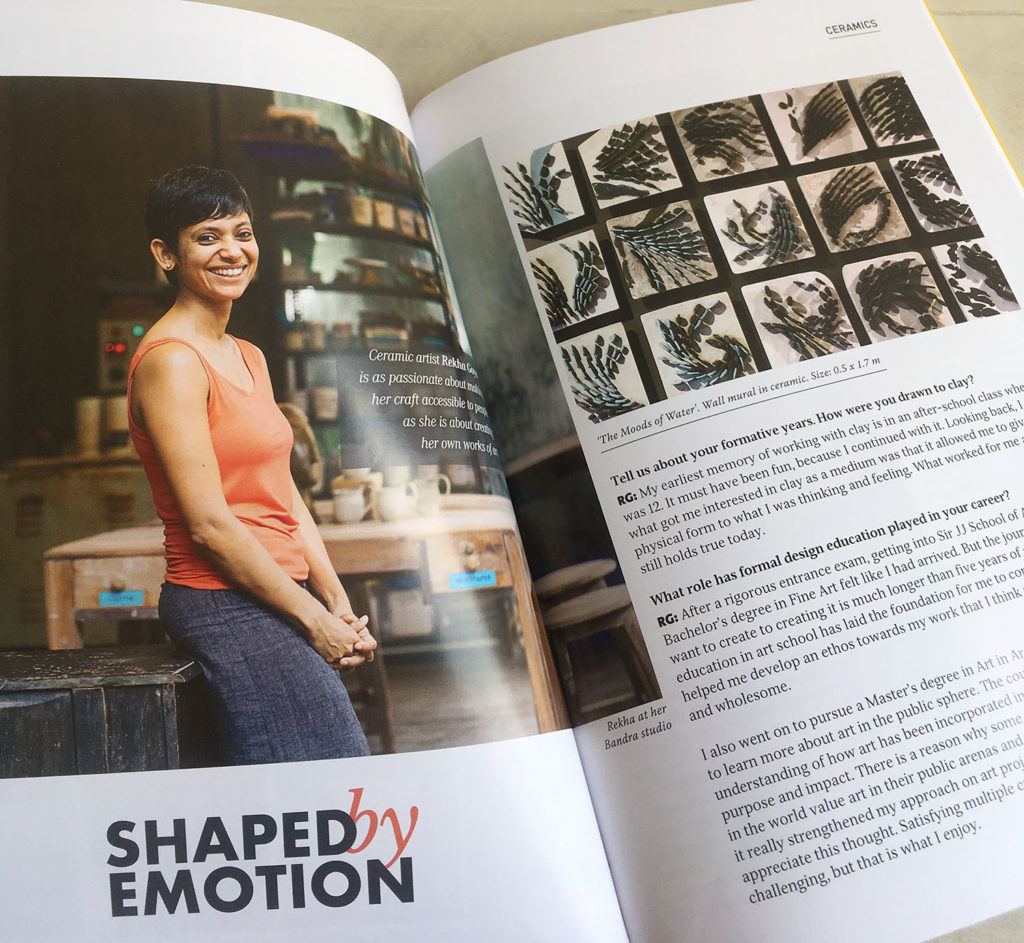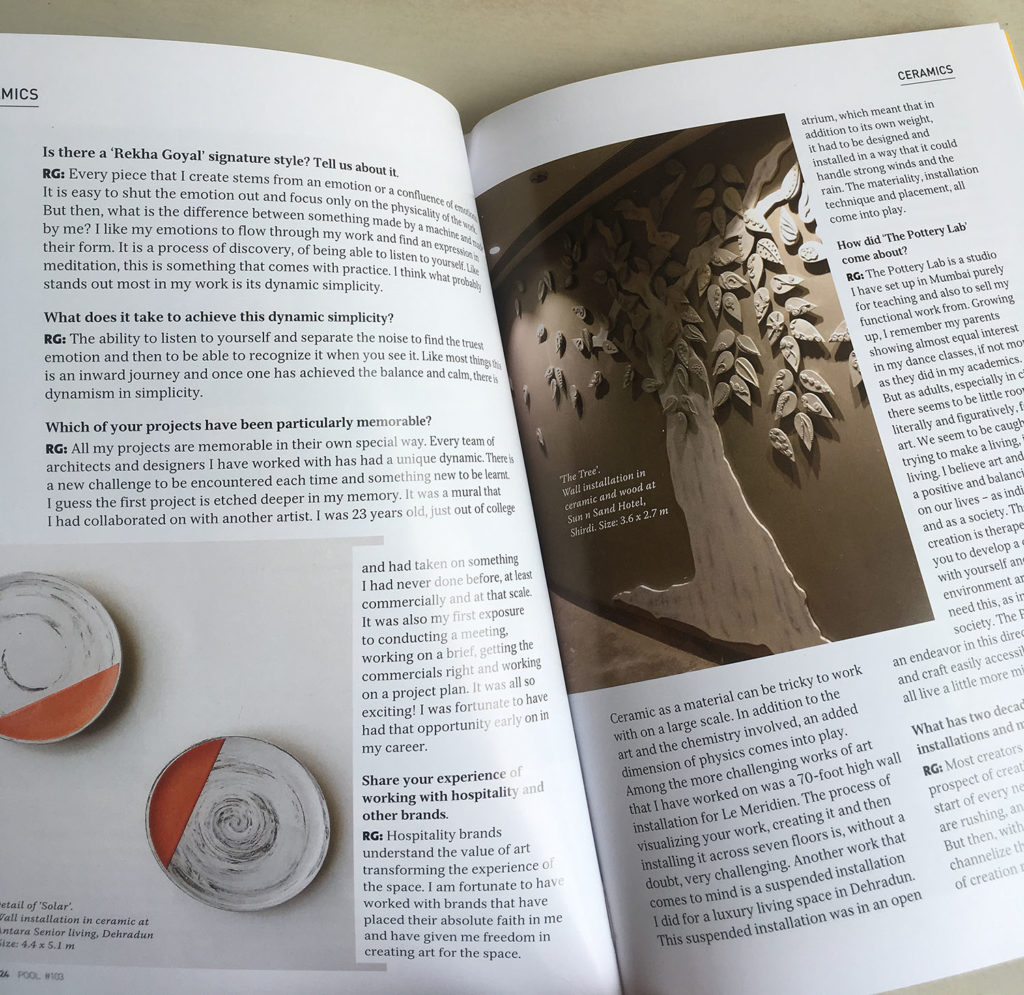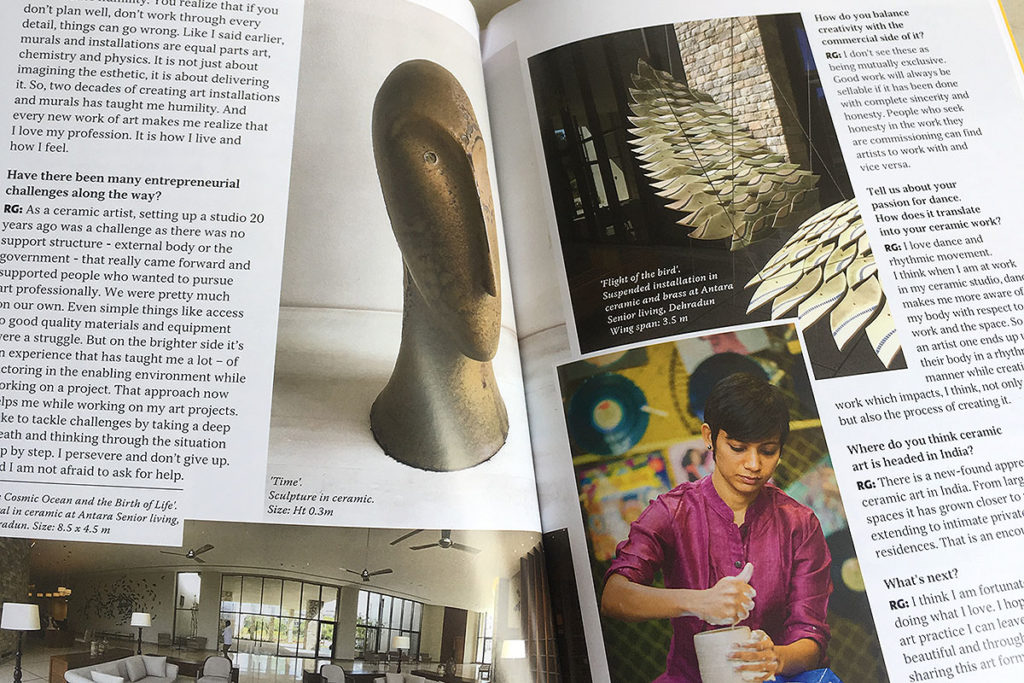Featured in POOL design magazine of March 2019. Here are some snapshots of the magazine and excerpts from the interview:



…
4.Is there a ‘Rekha Goyal’ signature style? Tell us about it.
Every piece that I create, stems from an emotion or a confluence of emotions. It is easy to shut the emotion out and focus only on the physicality of the work. But then, what is the difference between something made by a machine and made by me? I like my emotions to flow through my work and find an expression in their form. It is a process of discovery, of being able to listen to yourself. Like meditation, this is something that comes with practice.
I think what probably stands out most in my work is its dynamic simplicity.
5. Share your experience of working with hospitality and other brands. What has been the most challenging brief you ever got?
Hospitality brands understand the value of art transforming the experience of the space.
I am fortunate to have worked with brands where they have placed their absolute faith in me and have given me freedom in creating art for the space.
Ceramic as a material can be tricky to work with at large scales. In addition to the art and the chemistry involved, an added dimension of physics comes into play. Among the more challenging works of art that I have worked on was a 70-foot high wall installation for Le Meridien. The process of visualizing your work, creating it and then installing it across 7-floors is, without a doubt, very challenging. Another work that comes to mind is a suspended installation I did for a luxury living space in Dehradun. This suspended installation was in an open atrium, which meant that in addition to its own weight, it had to be designed and installed in a way that it could handle strong winds and the rain. The materiality, installation technique and placement, all come into play.
6. How did ‘The Pottery Lab’ come about?
Growing-up, I remember my parents showing almost equal interest in my dance classes, if not more, as they did in my academics. But as adults, especially in cities, there seems to be little room, literally and figuratively, for art. We seem to be caught-up in trying to make a living, instead of living. I believe art and craft has a positive and balancing impact on our lives – as individuals and as a society. The act of creation is therapeutic. It allows you to develop a connection with yourself and with the environment around you. We all need this, as individuals and as a society. The Pottery Lab has been an endeavor in this direction – to make art and craft easily accessible to people – so we all live a little more mindfully.
9. What had two decades of creating art installations and murals taught you?
Most creators get excited with the prospect of creating something new. At the start of every new project, your thoughts are rushing, and it is normal to get excited. But then, with experience one learns to channelize this excitement towards the act of creation rather than as an end. For experience also teaches humility. You realize that if you don’t plan well, don’t work through every detail, things can go wrong. Like I said earlier,
murals and installations are equal parts art, chemistry and physics. It is not just about imagining the aesthetic, it is about delivering it.
So, two decades of creating art installations and murals has taught me humility. And every new work of art makes me realize that I love my profession. It is how I live and how I feel.
10. Which entrepreneurial challenges have you faced in your journey? How do you tackle them?
As a ceramic artist, setting up a studio 20 years ago was a challenge as there was no support structure – external body or the government, that really came forward and supported people who wanted to purpose art professionally. We were pretty much on our own. Even simple things like access to good quality materials and equipment were a struggle. But on the brighter side it’s an experience that has taught me a lot – of factoring in the enabling environment while working on a project. That approach now helps me while working on my art projects.
I like to tackle challenges by taking a deep breath and thinking through the situation step by step. I persevere and don’t give up. And I am not afraid to ask for help.
11. How do you balance creativity with the commercial side of it?
I don’t see these as being mutually exclusive. Good work will always be sellable if it has been done with complete sincerity and honesty. People who seek honesty in the work they are commissioning can find artists to work with and vice versa.
13. What does it take to achieve the “dynamism of simplicity”?
The ability to listen to yourself and separate the noise to find the truest emotion and then to be able to recognize it when you see it.
Like most things this is an inward journey and once one has achieved the balance and calm, there is dynamism in simplicity.
14. Where do you see ceramic art is headed in India?
There is a new-found appreciation for ceramic art in India. From larger commercial spaces it has grown closer to people extending to intimate private spaces such as residences. That to me, is an encouraging move.
15. What’s next? Please share your aspirations.
I think I am fortunate that I can practice doing what I love.
I hope that through my art practice I can leave behind something beautiful and through my teaching continue sharing this artform.

